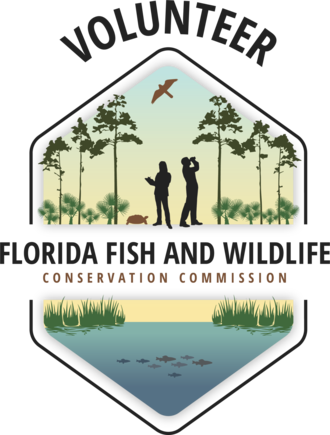
The Florida Fish and Wildlife Conservation Commission's (FWC) Regional Volunteer program is proud to introduce a new identifier celebrating the FWC's volunteer programs. This image highlights some of the key species and habitats that benefit from volunteer involvement, such as gopher tortoises, fish, pine flatwoods, birds and much more. Can you guess the species of bird in this image? More importantly, this image celebrates you and your dedication to conserving the landscapes, species and waterways that make Florida unique. Your efforts are priceless!
In this quarterly edition, we highlight the hard work of volunteers in the FWC's Southwest Region. We learn about protecting native species, tracking a keystone species, assisting the public with surrendering nonnative species, and planting marsh grass. We hope our newsletter inspires you to volunteer and support the place you visit or call home.
—
Sharon Tatem, Volunteer Program Manager
By Brendan O'Connor
Tyson Dallas, Biologist for the FWC's Nonnative program, illustrates the use of Havahart traps to Larry Wallace, an FWC volunteer involved in the Tegu Removal Project in Riverview, Florida. Photo by Brendan O'Connor, FWC.
Furnished with eggs, dowel
rods, a GPS unit and a sense of eagerness, a steadfast group of volunteers is
using its stealth skills to assist the FWC in trapping Argentine black and white
tegus. In the Riverview area southeast of Tampa, these volunteers have been
assisting the Wildlife Impact Management team in efforts to control a breeding
population of the Argentine black and white tegu. In partnership with
Hillsborough County, the FWC
is increasing efforts this season to survey for and remove this nonnative
species, which preys on a wide range of Florida's native species. The tegu eats a
variety of foods, including fruit, eggs, insects, and small animals such as
lizards, rodents and even gopher tortoise hatchlings. Exploiting tegus’ wide
range of diet, volunteers bait the traps with chicken eggs, strawberries and
even cat food to attract the tegus.
Volunteers have been
monitoring 24 traps distributed in dense scrub on Hillsborough County
properties. The traps have been checked every weekday since March 29, with
volunteers accumulating over 200 volunteer hours. The traps also accidently attract
some of our native species, which are released unharmed on site. The unexpected
visitors to the traps have included skunks, raccoons, opossums and most
recently a bobcat, much to the excitement of one of our volunteers who
successfully released it on site. All traps are monitored at least once every
24-hour period during the week. Eight volunteers have been sharing the
responsibility of inspecting the traps each weekday. The project is expected to
last into late summer, when tegus become dormant and enter “brumation,” the
stage of staying underground for long periods of time. Despite the hot Florida
summer, these volunteers plan to continue their efforts until the tegus become
inactive. If you see a tegu or any nonnative species, you can report it by
calling the FWC’s Exotic Species Hotline at 888-IVE-GOT1 (888-483-4681).
 |
Tegu in Havahart trap. Photo by Brendan O'Connor, FWC.
By Brendan O'Connor
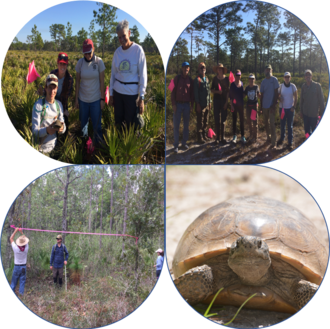 Volunteers involved in gopher tortoise surveys on Bullfrog Creek WEA. Photos by Brendan O'Connor, FWC.
Throughout
2017 and 2018, zealous volunteers have been busily wading through dense
vegetation, getting bitten by hungry mosquitoes and avoiding smilax, a thorny
plant that seems to grow out of the ground with the sole intention of tripping
the unwary. Keen eyes are also necessary to ensure everyone steers clear of any
venomous eastern diamondback rattlesnakes. “Why?” you may ask.
Bullfrog
Creek Wildlife and Environmental Area (WEA), is a 833-acre FWC property in
Hillsborough County, eight miles south of Riverview and southeast of Tampa.
Typically, habitat such as this is managed in part through prescribed fire,
which serves to promote new growth of plants as well as seed and fruit
production. However, Bullfrog Creek WEA is bordered to the west by Interstate
75, to the east by U.S. Route 301, and to the south and north by residential
properties. The layout of this WEA dictates very specific wind patterns and
weather parameters to safely undertake a prescribed fire, and hence the use of
prescribed fire is complemented by mechanical treatment. The mechanical
treatment aims to manage the density of saw palmettos and improve plant
diversity, which enhances available foraging opportunities for wildlife. The
challenge faced by land managers is that the property is also home to many gopher
tortoises, and their burrows must be avoided by the heavy machinery utilized for the mechanical treatment. This explains why our ardent volunteers have been busy
at work on this site.
Volunteers
have conducted line transect surveys across the WEA to identify and mark the
location of gopher tortoise burrows. Using brightly colored flags and GPS
units, volunteers traversed over 70 acres and identified the location of over
500 burrows. These volunteers were from the FWC’s Southwest Region Volunteer program, including groups such as the American Daughters of Conservation and
Florida Master Naturalist students. Volunteers are helping the FWC complete
its due diligence for one of Florida’s keystone species.
By Brendan O'Connor
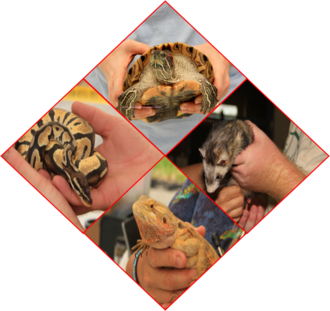 Species surrendered at the Exotic Pet Amnesty Day in St. Petersburg include (from top, clockwise) red-eared slider, ferret, bearded dragon and ball python. FWC photos.
On May 19, the FWC teamed up
with Friends of Boyd Hill Nature Preserve in St. Petersburg to host an Exotic
Pet Amnesty Day. The Exotic Pet Amnesty program is an effort to reduce the
number of nonnative species being released into the wild by pet owners. The
agency also facilitates the adoption of surrendered exotic pets by preapproved,
qualified adopters. Fourteen volunteers assisted at the event in St. Petersburg,
contributing 98 volunteer hours. With over 150 people attending, the event was
a great success. Thirty-one animals were surrendered and adopted, including one
bird, four mammals, and 26 reptiles.
The next Exotic Pet Amnesty
Day will be held on Sunday, August 19, at the South Florida Science Center and
Aquarium, West Palm Beach. Further details on volunteer opportunities for this
event will be posted on the FWC's calendar.
By Brendan O'Connor
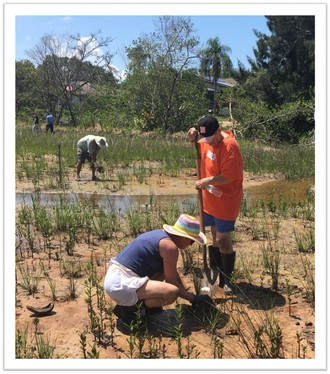 Volunteers plant marsh grass on Don Pedro Island State Park. FWC photo.
An
ongoing partnership between the FWC and the Florida Department of Environmental
Protection aims to restore fish and wildlife habitat, reduce erosion and help
stabilize the Florida coastline. On June 2, 28 volunteers assisted the agencies
with the planting of marsh grass at the Don Pedro Island State Park. The
wetland is being restored from a disturbed area, and since 2017, 21,643 plants
have been planted there, including 8,300 by volunteers. The planting efforts
were made possible by a grant from the U.S. Fish and Wildlife Service.
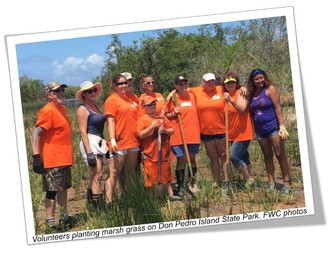
|